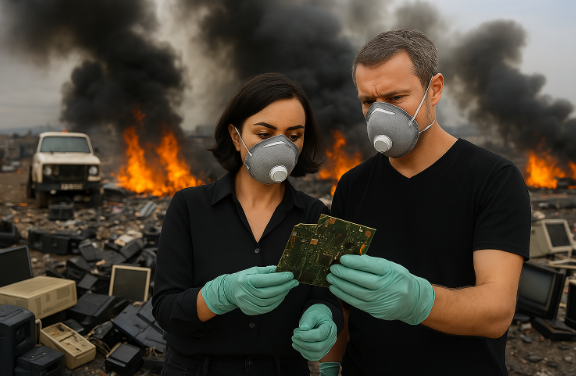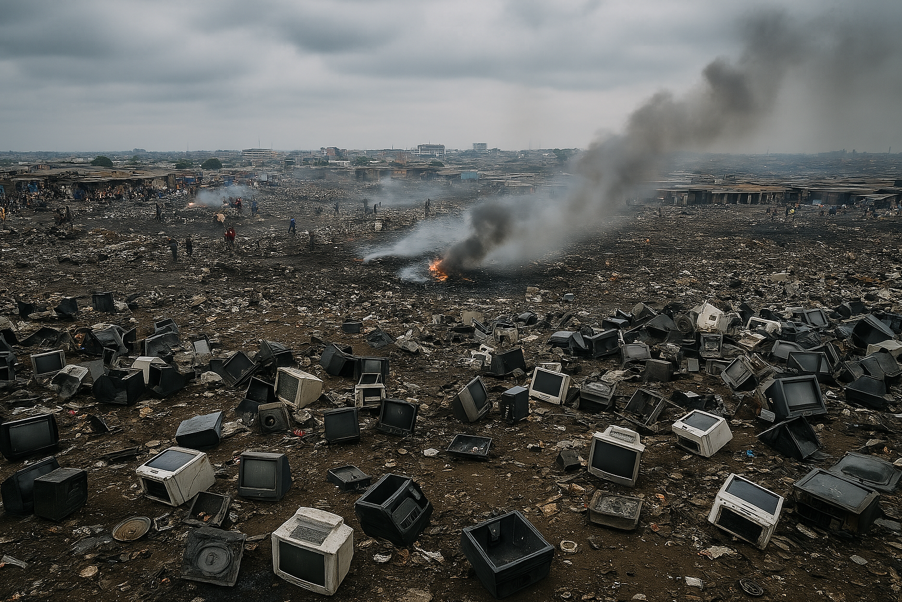What is E-Waste?
E-waste, or electronic waste, refers to discarded electronic devices that are no longer useful or functioning. It includes a wide range of products, from smartphones, computers, and televisions to home appliances like refrigerators, microwaves, and air conditioners. These devices often contain valuable materials, including precious metals such as gold and silver, as well as harmful chemicals and heavy metals like lead, mercury, and cadmium.
Why This Issue Matters
Improper disposal of e-waste is not just a logistical issue; it is a grave environmental and human health concern. Many electronic devices contain hazardous materials that can leak into the environment, contaminating soil and water and potentially harming wildlife and human populations. E-waste dumping also exacerbates the depletion of natural resources, as mining for new metals and materials contributes to environmental degradation. As e-waste continues to grow, it becomes increasingly urgent to address its disposal in a responsible, sustainable manner.
Environmental Impact of E-Waste

The environmental consequences of improperly disposed of e-waste are far-reaching and serious. From soil contamination to water pollution and air pollution, the impacts are widespread, affecting ecosystems, wildlife, and human health. Here, we explore the three primary environmental dangers associated with e-waste disposal.
Soil Contamination
One of the most significant environmental dangers posed by e-waste is soil contamination. Many electronic devices, particularly older models, contain hazardous materials such as lead, cadmium, and arsenic. When e-waste is dumped in landfills or left in unmanaged waste sites, these toxic substances can leach into the soil over time.
- Toxins like lead and cadmium leaching into the soil: Lead is commonly found in cathode ray tubes (CRTs) from older televisions and monitors, while cadmium is found in rechargeable batteries. When these devices degrade, their toxic components can seep into the ground, posing long-term contamination risks.
- Impact on agriculture and vegetation: The pollutants in the soil can affect plant growth, contaminating crops with harmful substances. Crops grown in polluted soil may absorb these toxins, leading to unhealthy food that can enter the human food chain.
- Indirect effects on the food chain: Contaminated soil doesn’t just affect plants; it also affects animals that rely on the plants for food. Herbivores that feed on contaminated vegetation can accumulate toxins in their bodies, which in turn impact the predators that rely on them. This creates a cascade effect that threatens entire ecosystems.
Water Pollution
Another significant consequence of e-waste dumping is water pollution. When e-waste is improperly discarded or burned, harmful chemicals and metals can seep into groundwater, rivers, lakes, and oceans.
- Chemical seepage into rivers, lakes, and aquifers: Electronic devices, particularly those with circuit boards, batteries, and capacitors, can release dangerous substances into water bodies. Substances like lead, cadmium, and brominated flame retardants are toxic to aquatic organisms, disrupting ecosystems and harming fish and other wildlife.
- Specific dangers posed by mercury and its transformation into methylmercury: Mercury, commonly found in older electronics, is particularly dangerous when released into the environment. Once in water, mercury can be transformed by bacteria into a more toxic form known as methylmercury. This chemical accumulates in the tissues of fish and marine organisms, entering the food chain and posing risks to both wildlife and humans who consume contaminated fish.
- Effects on marine ecosystems and drinking water sources: The contamination of aquatic systems can lead to the collapse of ecosystems, with species dying off or becoming unable to reproduce due to the presence of toxic chemicals. Moreover, mercury and other heavy metals can eventually contaminate drinking water sources, posing a serious health risk to human populations. This can lead to neurological and developmental issues, especially in children and vulnerable groups.
Air Pollution
Burning e-waste is a common but extremely dangerous practice in some parts of the world, especially in informal recycling sectors. The process of extracting valuable metals such as copper, gold, and aluminum from discarded electronics often involves burning plastic, cables, and other materials.
- Burning e-waste to extract metals: When electronic devices are burned, harmful substances such as dioxins, furans, and other toxic compounds are released into the atmosphere. These substances are known to be highly carcinogenic and can pose serious risks to human health, particularly in regions where people are exposed to the fumes.
- Release of harmful gases, particulate matter, and greenhouse gases: In addition to hazardous chemicals, burning e-waste releases particulate matter and greenhouse gases, contributing to air pollution. The particulate matter can cause respiratory diseases such as asthma, bronchitis, and lung cancer, especially in communities near e-waste disposal sites. Greenhouse gases, such as carbon dioxide and methane, contribute to global warming and climate change.
- Contribution to respiratory diseases and climate change: The pollutants released by burning e-waste directly affect human health, leading to a rise in respiratory diseases and other long-term health issues. For example, exposure to fine particulate matter (PM2.5) from burning plastics can irritate the lungs and exacerbate pre-existing conditions like asthma. Additionally, the release of carbon dioxide and other greenhouse gases from e-waste burning contributes to the global climate crisis, further exacerbating environmental damage.
Why Does E-Waste Dumping Persist?

Despite its dangers, improper e-waste disposal continues due to several factors:
- Lack of Awareness: Many consumers are unaware of the risks posed by e-waste or the proper channels for recycling it.
- Cost Barriers: Recycling electronics responsibly is more expensive than dumping them, deterring businesses and individuals.
- Informal Recycling: In developing regions, informal workers often process e-waste using harmful methods to extract valuable materials.
Solutions: Turning the Tide on E-Waste
The fight against e-waste starts with awareness and action. Here’s how we can reduce its harmful impacts:
Recycle Responsibly
Take your old devices to certified e-waste recycling facilities, which ensure proper disposal and material recovery without harming the environment. Many manufacturers and retailers offer recycling programs as well.
Support Right-to-Repair Initiatives
The global right-to-repair movement pushes manufacturers to make devices easier to repair. Supporting this initiative can extend the lifespan of your electronics, reducing the need for new devices and cutting down on e-waste.
Buy Smarter
Choose products designed with sustainability in mind. Look for brands that prioritize modular designs and offer take-back or repair services.
Spread Awareness
Educate your community about the dangers of improper e-waste disposal and the steps they can take to dispose of electronics responsibly.
